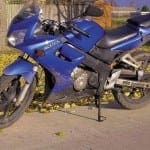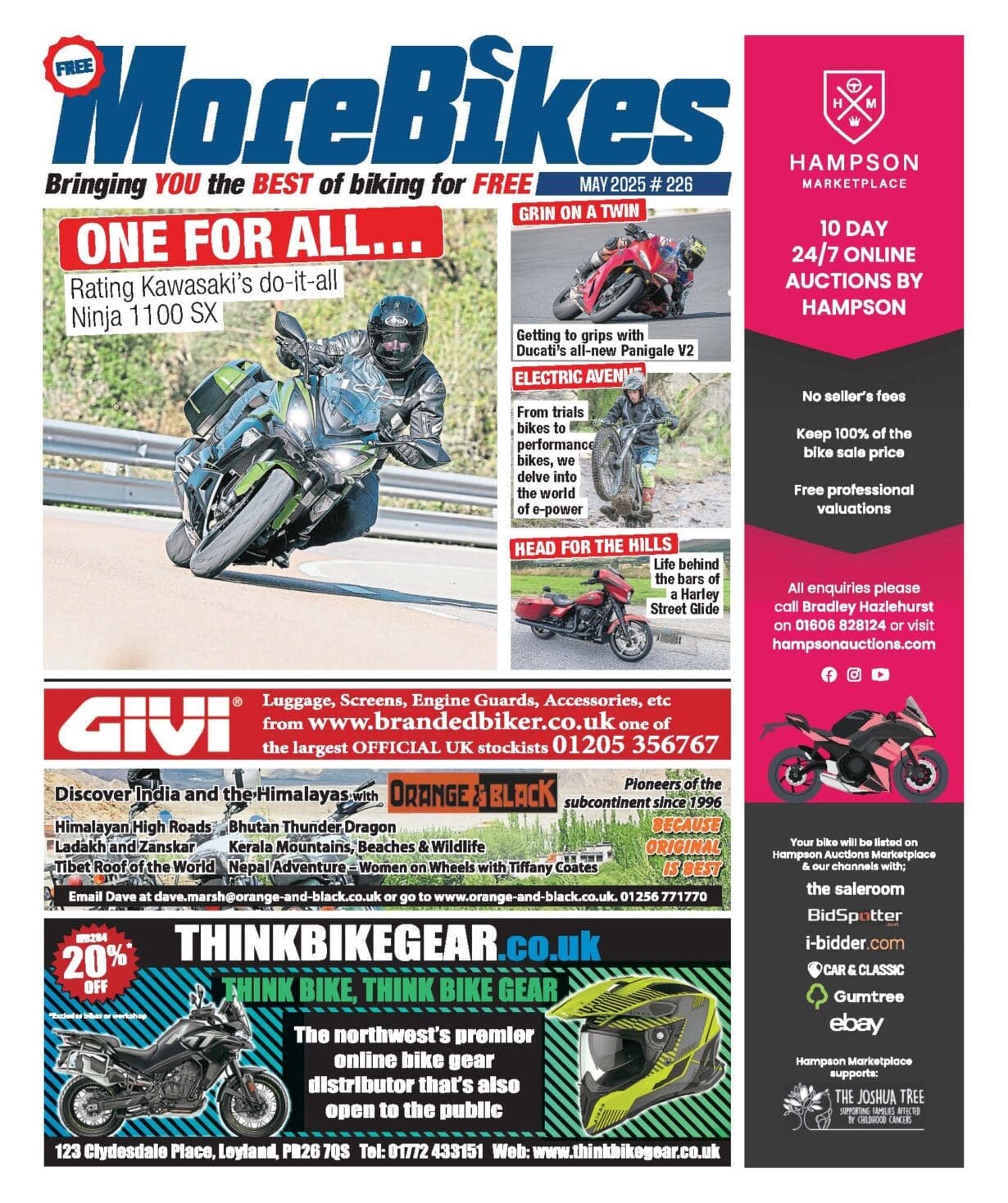Most new riders take the Direct Access route into motorcycling.
Helen Weighill opted instead to hang L-plates on a Honda
CBR125RR. That was in May 2005. She passed her test 17 months
later but is still riding the little four-stroke and on 1 December 2006
the mileage stood at 34,888.
My first bike was a Honda Vision NH80 scooter. Motorcycles have
always been part of the Weighill family and my parents bought me that for
my 21st birthday. The Vision and I were together four years and although we had our problems – it ate spark plugs, broke a crank and got itself stolen – another Honda was top of my wanted list when it came to
buying a replacement.
The CBR125RR entered my life in May 2005. I bought it from A1 Honda in Stamford. The OTR price of £2700 included heated handlebar grips, a Scottoiler and heavy duty Oxford lock and chain. It seemed just what I was looking for, but making the switch from ‘twist and go’ scooter to six-speed motorcycle was a mix of delight and despair. I loved my new buy but there were days when I wondered if I would ever get the hang of clutchgear- throttle coordination or a feeling for the far superior brakes. It took about two weeks before it all fell into place.
Since then it has remained my sole form of transport. I don’t drive a car and although I passed my motorcycle test nearly two years ago I have never felt the need to rush out and buy something bigger. That said, my dad and I have been working on the refurbishment of a 22-year-old ‘Babyblade’ CBR400. That is going to be my next steppingstone and I fancy giving road racing a go too, but I have no plans to part with my 125 just yet.
That so few other riders now see the advantages of starting out on a 125 really surprises me. On a visit to a race meeting at Cadwell Park I didn’t see any other 125s or a single machine with L-plates.
When I put the Honda in for its first MoT a few months back, the tester could not believe the mileage, but living in rural Lincolnshire it soon mounts up. I ride all year round and in just about all weathers, bar gale force winds and snow – I am not a masochist!
During my first two years with this bike I was travelling a daily 44-mile round trip to work, sometimes six days a week. I now do a 30-mile round trip to college each day and it’s fantastically fuel-efficient. Would you believe 94.5mpg – a good reason in itself for not trading up to something bigger. I’ve also stuck with the original IRC make of tyres because wear rate is excellent and they give good handling. In addition to my commuting, the Honda has taken me on the 150-mile return journey to the metal and rock music Download Festival held annually at Donington Park. That’s a Friday to Sunday event and I rode there and back each day. I certainly don’t let the fact it’s a 125 put me off making longer journeys because it accelerates well, has no problem keeping up with the traffic, is comfortable, reliable and sips fuel. Even though the suspension is non-adjustable (I’m a lightweight rider and it barely moves when I sit on it) the comfort on long journeys and winding roads is great. There is no annoying vibration through the bars or pegs. On those occasions it does start ‘grumbling’ I know the spark plug needs changing. This early warning sign is also accompanied by a slight loss of power and crops up at intervals of about 5000 miles.
Although it’s a sports-style machine the riding position is not akin to ‘a monkey copulating with a football’. Backache has never been a problem. The screen gives good protection but the bike is pushed and bullied by heavy crosswinds and I have to knock it down a gear to keep going at a reasonable pace when challenging strong headwinds.
At 5ft 3in I can touch the floor with both feet and would thoroughly recommend this bike to petite riders. The Scottoiler I had fitted has been a good investment and a Givi rack and topbox has given me extra carrying space without disturbing the handling.
I would also recommend the switch I made to quartz halogen headlamp bulbs, which give much better light, but the aftermarket heated grips have been a bit hit and miss and I gave up on them after the right grip failed for the second time.
There have been a few niggles with the machine itself but they have been easily ironed out. The important things is to get it serviced at the factory recommended intervals. A mystery problem that once struck saw the bike lose power and then stop as if it had run out of petrol. We eventually discovered that the air feed pipe to the fuel tank had been pinched closed during a service. If air can’t get in, fuel can’t get out – simple as that, but it is something to watch out for whenever the tank is removed to replace an air filter or check the valve clearances, for example.
I’ve crashed a couple of times but damage to the bike has been limited to a slightly grazed handlebar weight and winker, and a bent footpeg – things easily put right with little expense.
After struggling with seized fairing screws, they were all changed for stainless steel. Why, oh why don’t manufacturers use these as standard when the extra cost is negligible? They don’t corrode, the heads don’t get chewed up, and when copper slipped they’re always easy to remove. On a bike where the simplest service means removing a panel these little beauties make it even easier to live with.
The quality of the engine finish is superb but the overall finish of the bike is let down by a few minor details. My chrome fork caps rusted early in the bike’s life and the swinging arm suspension mount shows corrosion. It would also be nice if a rear hugger was standard, not only to protect the suspension from road crud but to add that finishing touch to the bike’s appearance.
The Japanese have a lovely term called ‘kaizen’ which can mean, ‘small change, big difference’. They may as well file the words ‘Iridium spark plug’ under the definition after the difference it made to the bike. More expensive than ordinary spark plugs, you wonder just how three millimetres of a rare metal (which sounds like it could be an atom bomb ingredient) can have such an effect. I was surprised at how noticeable the change was. It made my mouth form one of those ‘broad grin’
things. The bike was definitely a new beast with more grunt and felt like it still wanted to produce more even when the throttle was fully open. Where the bike had been doing 65-70mph flat out depending on its mood, it now does 70 quite happily. So those three millimetres of wonder metal seem to have turned my bike into an athlete!
Would I buy a CBR125 again? Without hesitation. For everyday riding this bike covers all bases.
Tech Spec
Bought May 2005
■ Price: £2700 OTP (including Scottoiler, heated grips and Oxford lock and chain.
■ Owner: Helen Weighill, 28, media student, Lincolnshire
■ Engine: Liquid cooled, single cylinder, sohc. Bore and stroke 58 x 47.2mm. Capacity 124.7cc. 28mm CV carburettor.
■ Power: 13bhp
■ Transmission: 6-speed gearbox, wet multi plate clutch, final drive chain.
■ Rolling Chassis: Twin spar steel frame with 31mm telescopic front fork and single rear shock. Six-spoke, 17in alloy wheels front and rear. Single 276mm front disc with Nissin caliper, 220mm single rear disc with Nissin caliper.
■ Weights and measures: Wheelbase 1294mm. seat height 776mm, dry weight 115kg, fuel capacity 10 litres including reserve
■ The 2009 CBR125RR features fuel injection






